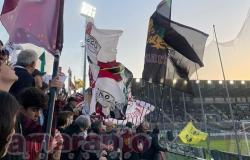Numbers: Milan has 5 times as many, Rome almost 4, Turin 1 and a half and even Florence with its 380,000 inhabitants has a few thousand more than Naples-Naples which has three times as many inhabitants. Yet the impact they have here is very particular and takes on forms unthinkable for any other European city. We are talking about immigrants who, as is normal, would all like to fly to the North. There is work there. There the flow of history passes quickly. Not here. Whoever gets stuck here will end up settling into a mix that in Naples – a crossroads of ethnic groups and colors for twenty-one centuries – has characteristics made unique by its history.
A mix of lives thrown onto this earth pregnant with nostalgia, where the hope of improving one’s destiny clashes with the chronic inability to develop a workable theory of existence. Where the nostalgia for a home lost forever is reshaped by the roughness of precariousness as well as by the lightness of “who had, had, had/gave, gave, gave”. Which is what makes this part of humanity migrant, poetic and universal.
Other numbers: of the migrants settled in Naples, 39.9% come from Europe, 37.5% from Asia, 17.5% from Africa. The latter are the ones that are most noticeable because they have largely taken root near the station. Or they drop us in from the endless suburbs every day, in the hope of making ends meet. Like little Katy, an identity suspended between Casalnuovo and Mogadishu, neither Italian nor Somali; she, every morning gets on the 169 to Piazza Garibaldi where there is everything and the opposite of everything. In its own way, it is different from other stations, because it mixes the collapse of marginality with the obtuse hope of being the gateway to Europe.
Reopened to the public after years, the works disfigured the dignity of this square of Umbertine buildings with clumsy yearnings for modernity, so the vast area in front of the station quickly fell back into worse degradation than before. Here, all an up and down of fraveca and sfraveca, vènnere or accattà, just like before, only that before everything flowed in the alleys around the square, while now it unrolls in the shadow of enormous, mysterious metal cubes of which most people ( including us) escapes their future function and in the meantime they serve as outdoor toilets for the underprivileged and homeless.
Be that as it may, Katy’s for Piazza Garibaldi is an obsession that the woman cultivates daily: here she sells strange foods in brightly colored bags mostly purchased from other Africans. In the afternoon you travel between Porta Nolana and Porta Capuana and at night you cross the distant galaxies again with the 169. You don’t really want to talk to us, what’s the point of you? But by buying something we give her a small reason to do so: “you can feel death, we can see it…” she repeats like a dirge, then explains, “my father was a general, my brothers were also in the army. They made me run away when I was a little girl… they’re all dead but I didn’t see them. My mother, however, was from another tribe and, therefore, I do not belong to either of them. I’m also illegal at home” Katy continues, biting her lip, “a cousin could kill me or see me as an enemy. I’m not coming back for my son and to keep my loved ones alive. Because staying in Naples I don’t see their death: they are all alive.”
Garibaldi Square. The war left behind that reappears from the mobile phones of travellers, the sin of piecework sex and devastation, but also many ideas of redemption with mosques and churches of mysterious cults that emerge from garages. Katy’s son. If the mother’s identities are suspended between Casalnuovo and Mogadishu, those of his son are granitically Neapolitan, with his movements like a boy from the Quartieri Spagnoli, he perfectly represents that enveloping identity mechanism that we call cross-breeding. And he is, Katy’s son, paradoxically more foreign to his own mother than to us. Settled in this land where illegality reigns supreme, the boy is progressively sliding towards petty crime which, with the fraying of the Camorra clans following the pandemic, now sees a progressive opening of spaces of marginality to the new delinquency of non-Neapolitans . Aliens who do not have racial diversity, in the sense of white, red or black, but a single common denominator: hunger. And the same dialect becomes the mother tongue for many of them, as in a paradox of an uncertain motherhood. On the planet Naples, in order to withstand its many shames, we must also reinvent the conditions that make new forms of life possible.

Thus, both the very small things and universal values blend together in a desire for survival that excludes, a priori, any racism; better, it identifies it in two unique races: those who eat and those who are eaten. In the maze of alleys around Piazza Garibaldi even bourgeois moralisms break down in the sly gaze of the many African girls, what a tragic fate of having nothing but your own body to survive. The smile as the only bulwark against a nightmare that would make life itself impracticable, because it lacks air, light, food. That search therefore for a possible “Daily Bread”, which creates bonds, sometimes very violent, but at times capable of unleashing horizontal solidarity. So you discover that even the flight of migrants, its evolution, acquires different meanings from time to time and while there are those who run for fear of not eating, there are those who run to escape from their own fear. Migrations, both those that come to us and ours, have an infernal driving force in fear. We escape from a war, from a certain and inevitable misery, but we also escape through evasion, through escape from too many selves escaped by the voids. Thus this immense and varied humanity disperses indistinctly in fear, but mysteriously also discovers the sweetness of a hybrid and inexplicable authenticity. It is the vertigo of nothingness that pushes us to mix, to be together, to see Osimhen’s goals as answered prayers.
«To you they all seem the same but the Africans are among themselves, not only different in origins but also in destiny… the Senegalese have trade in their blood, the Tanzanians are hard workers, the Nigerians like to show off… » speaking is Luca, forty years old, rotten green cap with visor, tribal tattoos on his forearms: more than the Combonian who lived in an African slum for ten years, he looks like a gangsta-rapper. Luca now works for Caritas and often passes by the Naples station to take care of some particular case: «once they arrive in Naples, most Africans take a train to Caserta and from there to Castelvolturno, the Soweto of Europe, from where they then disperse throughout Italy to bust their backs with the grape harvest or to collect oranges, tomatoes… all strictly under the table. Castelvolturno where on average 20, 30 thousand migrants are stationed who came here from Mamma Africa in the illusion of escaping hell, ended up stuck in another hell made up of illegal immigration, Camorra, gangmastering, illegal construction sites, prostitution, Pentacostal shepherds, connection-houses… but that’s another story. The one that Io Capitano didn’t have time to tell.
Third and final episode of the reportage on Naples. The first episode was released on Alias on March 9th, the second on March 16th





